
|
Now it is very bright as 7.0 mag (Apr. 25, Willian Souza). It will approach to Sun down to 0.43 a.u. in May, and it is expected to brighten up to 3.5 mag. In the Southern Hemisphere, it stays observable in good condition until mid May. In the Northern Hemisphere, it is only visible in extremely low sky in late May. Then it appears in the morning sky at 11 mag in August. And it will be observable in good condition after that while the comet will be fading.
Date(TT) R.A. (2000) Decl. Delta r Elong. m1 Best Time(A, h)
Apr. 25 23 33.34 -26 30.4 0.912 0.891 55 6.8 3:44 (295,-10)
May 2 0 3.01 -15 10.5 0.716 0.761 48 5.6 3:34 (284, -6)
|
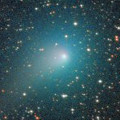
|
Now it is 8.2 mag (Apr. 25, Charles S. Morris). It stays bright as 8-9 mag until July. It is observable in good condition in the Northern Hemisphere. In the Southern Hemisphere, it is not observable until late June.
Date(TT) R.A. (2000) Decl. Delta r Elong. m1 Best Time(A, h)
Apr. 25 5 16.68 75 29.6 1.721 1.621 67 8.2 20:12 (162, 37)
May 2 6 27.84 76 18.8 1.702 1.616 67 8.1 20:20 (164, 39)
|
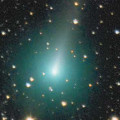
|
Now it is very bright as 7.9 mag (Apr. 24, Katsumi Yoshimoto). It continues brightening even after the perihelion passage on Mar. 15. It stays observable for a long time in the Northern Hemisphere. In the Southern Hemisphere, it is not observable until June when it fades down to 13-14 mag. It seems to be a fragment of C/1988 A1 (Liller), like C/1996 Q1 (Tabur) and C/2015 F3 (SWAN).
Date(TT) R.A. (2000) Decl. Delta r Elong. m1 Best Time(A, h)
Apr. 25 1 53.61 76 6.3 1.122 1.116 62 8.8 3:44 (194, 27)
May 2 5 13.04 82 36.3 1.106 1.199 68 9.6 20:20 (171, 36)
|
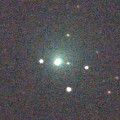
|
Now it is very bright as 9.6 mag (Apr. 22, Chris Wyatt). Brightening very rapidly. It will approach to Sun down to 0.9 a.u. in June, and it is extected to brighten up to 5.5 mag. In the Southern Hemisphere, it stays observable in good condition for a long time after this. In the Northern Hemisphere, it will be unobservable from late March to late June.
Date(TT) R.A. (2000) Decl. Delta r Elong. m1 Best Time(A, h)
Apr. 25 4 58.15 -22 29.7 1.620 1.318 54 9.9 20:12 ( 67, -7)
May 2 5 14.54 -22 13.5 1.528 1.238 53 9.3 20:20 ( 70,-10)
|
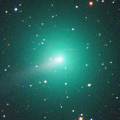
|
Now it is 8.9 mag (Apr. 25, Charles S. Morris). The nucleus was split into some fragments in late March, and the brightness evolution stopped. It brightened up to 7.0 mag in late March ((Mar. 30, Charles S. Morris). However, it is fading now. It moves along the same orbit as C/1844 Y1 (Great Comet). It approaches to Sun down to 0.25 a.u. on May 31. It was expected to brighten up to -1 mag. But it may disappear before the perihelion passage. In the Northern Hemisphere, it stays observable in excellent condition until mid May. In the Southern Hemisphere, it is not observable until June.
Date(TT) R.A. (2000) Decl. Delta r Elong. m1 Best Time(A, h)
Apr. 25 5 41.10 62 33.5 0.956 1.006 61 9.4 20:12 (146, 39)
May 2 5 13.77 59 31.3 0.916 0.856 52 9.6 20:20 (144, 31)
|
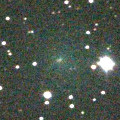
|
Now it is very bright as 10.3 mag (Apr. 22, Chris Wyatt). It will approach to Sun down to 0.3 a.u. on July 3, and it is expected to brighten up to 2.5 mag. In the Southern Hemisphere, it stays observable in good condition until early June when it brightens up to 8 mag. But it will not be observable around the perihelion passage. In the Northern Hemisphere, it is not observable now. It will appear in the evening sky at 3-4 mag in mid July, then it stays observable while getting fainter.
Date(TT) R.A. (2000) Decl. Delta r Elong. m1 Best Time(A, h)
Apr. 25 6 15.33 -27 39.4 1.619 1.619 71 10.8 20:12 ( 53, 4)
May 2 6 11.00 -22 29.8 1.621 1.497 64 10.3 20:20 ( 62, 0)
|
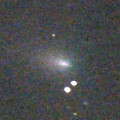
|
Recovered from SWAN images after 24-year blank. Now it is very bright as 10.7 mag (Apr. 7, Michael Mattiazzo). It stays 10-11 mag until August. In the Southern Hemisphere, it stays observable in the morning sky for a long time. In the Northern Hemisphere, it is too low to observe until July.
Date(TT) R.A. (2000) Decl. Delta r Elong. m1 Best Time(A, h)
Apr. 25 23 55.67 0 16.0 2.119 1.430 35 10.5 3:44 (270, 0)
May 2 0 18.88 1 54.9 2.084 1.410 36 10.3 3:34 (268, 0)
|
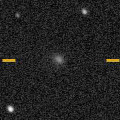
|
Now it is 10.8 mag (Apr. 20, Sandor Szabo). It appeared in the evening sky in the Northern Hemisphere. It will appear in the evening sky at 15 mag in mid May also in the Southern Hemisphere. However, it will fade out rapidly, and will be fainter than 18 mag in June.
Date(TT) R.A. (2000) Decl. Delta r Elong. m1 Best Time(A, h)
Apr. 25 4 26.80 25 18.2 1.132 0.640 34 12.9 20:12 (111, 15)
May 2 5 22.77 28 35.1 1.091 0.728 40 13.8 20:20 (111, 21)
|
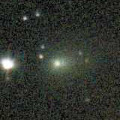
|
Now it is 14.3 mag (Apr. 22, Chris Wyatt). Brightening very rapidly. It will brighten up to 8-9 mag from summer to autumn. It will be observable in excellent condition in the Southern Hemisphere. It locates very low around the high light in the Northern Hemisphere.
Date(TT) R.A. (2000) Decl. Delta r Elong. m1 Best Time(A, h)
Apr. 25 13 3.06 -1 58.4 1.102 2.076 159 13.4 22:47 ( 0, 53)
May 2 12 55.65 -1 33.4 1.086 2.029 151 13.1 22:12 ( 0, 53)
|
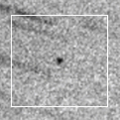
|
It will approach to Sun down to 0.34 a.u. and brighten up to 7 mag in June. In the Southern Hemisphere, it will appear in the evening sky at 7 mag in early July. Then it stays observable in good condition while the comet will be fading. In the Northern Hemisphere, it is not observable until mid August when the comet will fade down to 12 mag.
Date(TT) R.A. (2000) Decl. Delta r Elong. m1 Best Time(A, h)
Apr. 25 1 57.37 18 1.4 2.301 1.304 5 14.5 3:44 (237,-12)
May 2 2 17.50 19 43.8 2.196 1.200 6 13.5 3:34 (236,-12)
|

|
Now it is 13.3 mag (Apr. 20, Sandor Szabo). It stays bright as 13 mag until June. In the Southern Hemisphere, it will never be observable again.
Date(TT) R.A. (2000) Decl. Delta r Elong. m1 Best Time(A, h)
Apr. 25 0 56.45 60 9.9 4.088 3.510 48 13.6 3:44 (211, 23)
May 2 1 6.06 62 13.4 4.110 3.541 49 13.7 3:34 (210, 25)
|
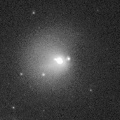
|
Now it is not observable. It will appear in the morning sky in June.
Date(TT) R.A. (2000) Decl. Delta r Elong. m1 Best Time(A, h)
Apr. 25 1 43.01 19 2.0 6.791 5.799 8 13.9 3:44 (239, -9)
May 2 1 48.64 19 34.5 6.781 5.800 12 13.9 3:34 (240, -7)
|
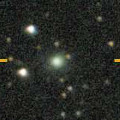
|
Now it is 14.3 mag (Apr. 22, Sandor Szabo). It will brighten up to 10.5 mag from 2020 December to 2021 January. In the Northern Hemisphere, it stays observable in good condition while the comet will be brightening gradually, but it is not observable at the high light. In the Southern Hemisphere, it is not observable for a long time, but it will be observable in good condition after the high light.
Date(TT) R.A. (2000) Decl. Delta r Elong. m1 Best Time(A, h)
Apr. 25 16 38.14 79 45.7 3.119 3.194 85 14.0 2:26 (180, 45)
May 2 15 34.24 80 12.8 3.067 3.129 84 13.9 0:56 (180, 45)
|
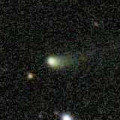
|
Now it is 14.2 mag (Apr. 14, Sandor Szabo). It stays 13-14 mag from 2020 to 2021. It stays observable in good condition for a while.
Date(TT) R.A. (2000) Decl. Delta r Elong. m1 Best Time(A, h)
Apr. 25 12 40.59 17 35.8 2.419 3.271 142 14.2 22:25 ( 0, 72)
May 2 12 36.82 17 20.7 2.456 3.255 135 14.2 21:53 ( 0, 72)
|
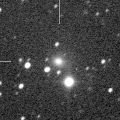
|
Now it is bright as 13.9 mag (Apr. 22, Chris Wyatt). It stays 15 mag until summer. It stays observable for a long time in the Southern Hemisphere. It is not observable until August in the Northern Hemisphere.
Date(TT) R.A. (2000) Decl. Delta r Elong. m1 Best Time(A, h)
Apr. 25 2 30.19 -42 32.2 4.153 3.684 55 14.7 20:12 ( 62,-43)
May 2 2 36.95 -41 8.7 4.167 3.707 56 14.8 3:34 (295,-47)
|
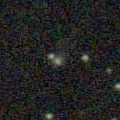
|
Now it is 15.8 mag (Mar. 18, Toshihiko Ikemura, Hirohisa Sato). It will brighten up to 13 mag in 2021. In 2020, it is observable at 15 mag in good condition from spring to summer.
Date(TT) R.A. (2000) Decl. Delta r Elong. m1 Best Time(A, h)
Apr. 25 14 35.58 -19 42.6 4.171 5.167 171 15.2 0:24 ( 0, 35)
May 2 14 30.06 -20 2.4 4.121 5.126 175 15.2 23:46 ( 0, 35)
|
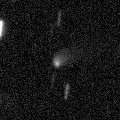
|
Now it is 15.4 mag (Apr. 22, Chris Wyatt). It stays 14-15 mag until 2021. In the Southern Hemisphere, it stays observable in good condition for a long time. In the Northern Hemisphere, it is not observable until June in 2021.
Date(TT) R.A. (2000) Decl. Delta r Elong. m1 Best Time(A, h)
Apr. 25 17 16.54 -81 38.3 4.701 5.116 108 15.5 3:07 ( 0,-27)
May 2 17 10.81 -82 31.5 4.635 5.086 111 15.4 2:35 ( 0,-28)
|
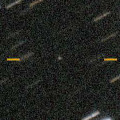
|
Now it is 16.9 mag (Mar. 20, Kunihiro Shima). It will brighten rapidly, and will brighten up to 9.5 mag in June. It is not observable in June. However, it stays observable in good condition until May while the comet is brightening, and after July while the comet will be fading.
Date(TT) R.A. (2000) Decl. Delta r Elong. m1 Best Time(A, h)
Apr. 25 9 38.02 -1 26.7 0.547 1.310 111 16.1 20:12 ( 21, 52)
May 2 9 19.32 1 50.1 0.526 1.212 99 15.4 20:20 ( 42, 49)
|
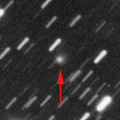
|
Now it is 15.7 mag (Apr. 20, Sandor Szabo). It is expected to be observable at 5-6 mag for a long time from 2022 to 2023. In the Northern Hemisphere, it is not observable at the high light from 2022 summer to 2023 summer. In the Southern Hemisphere, it is only visible in the extremely low sky in summer in 2020. But it will be observable in good condition at the high light.
Date(TT) R.A. (2000) Decl. Delta r Elong. m1 Best Time(A, h)
Apr. 25 18 14.44 51 39.2 9.140 9.310 96 15.5 3:44 (189, 73)
May 2 18 11.80 52 6.9 9.062 9.259 98 15.5 3:31 (180, 73)
|
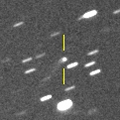
|
Now it is 16.5 mag (Apr. 2, W. Hasubick). It stays 15-16 mag for a long time until 2021.
Date(TT) R.A. (2000) Decl. Delta r Elong. m1 Best Time(A, h)
Apr. 25 20 54.14 1 55.5 4.578 4.496 79 15.8 3:44 (299, 37)
May 2 20 52.73 3 23.0 4.458 4.491 85 15.8 3:34 (302, 42)
|
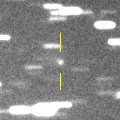
|
First return of a new periodic comet discovered in 2006. It brightened up to 14.9 mag in January (Jan. 21, R. Fichtl). It will never be observable after this.
Date(TT) R.A. (2000) Decl. Delta r Elong. m1 Best Time(A, h)
Apr. 25 2 44.28 4 10.0 2.710 1.740 12 15.8 20:12 (109,-18)
May 2 3 3.67 5 23.3 2.732 1.758 11 15.9 20:20 (113,-20)
|
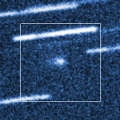
|
New comet. Now it is 14.9 mag (Apr. 14, John Drummond). It approached to Sun down to 0.5 a.u. in March, and it must have brightened up to 14 mag. It will fade out very rapidly after this.
Date(TT) R.A. (2000) Decl. Delta r Elong. m1 Best Time(A, h)
Apr. 25 6 27.54 -0 35.2 0.661 0.943 65 15.8 20:12 ( 70, 25)
May 2 7 27.93 -2 10.9 0.687 1.050 73 16.4 20:20 ( 64, 28)
|
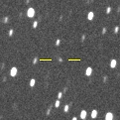
|
Now it is 17.2 mag (Mar. 20, Toshihiko Ikemura, Hirohisa Sato). It will stay at 14 mag for a long time from 2021 to 2022. In the Northern Hemisphere, it stays observable in good condition while brightening gradually. In the Southern Hemisphere, it is appearing in the morning sky. But it stays locating low for a long time.
Date(TT) R.A. (2000) Decl. Delta r Elong. m1 Best Time(A, h)
Apr. 25 19 10.52 33 13.0 6.347 6.512 94 16.2 3:44 (271, 75)
May 2 19 7.51 33 35.4 6.241 6.480 99 16.1 3:34 (273, 79)
|
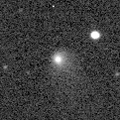
|
It brightened up to 13.8 mag in autumn in 2019 (Sept. 3, Chris Wyatt). Now it is fading slowly. It is appearing in the morning sky in the Southern Hemisphere. It will appear in June also in the Northern Hemisphere. In 2020, it stays observable in good condition while the comet will be fading from 16 to 17 mag.
Date(TT) R.A. (2000) Decl. Delta r Elong. m1 Best Time(A, h)
Apr. 25 0 17.86 -6 56.0 6.235 5.436 34 16.2 3:44 (273, -8)
May 2 0 21.64 -6 7.4 6.210 5.475 39 16.3 3:34 (274, -5)
|

|
It brightened up to 13.2 mag from spring to autumn in 2019 (June 30, Thomas Lehmann). Now it is fading slowly. In the Southern Hemisphere, it becomes low from February to March, but it stays observable for a long time. In the Northern Hemisphere, it is not observasble until June.
Date(TT) R.A. (2000) Decl. Delta r Elong. m1 Best Time(A, h)
Apr. 25 23 58.79 -33 12.0 4.364 3.892 56 16.3 3:44 (298,-19)
May 2 0 2.42 -32 29.5 4.325 3.929 60 16.3 3:34 (299,-16)
|
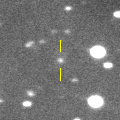
|
Now it is 16.7 mag (Mar. 19, D. Buczynski). It will brighten up to 12 mag in winter in 2022. In the Northern Hemisphere, it stays observable in good condition for a long time. In the Southern Hemisphere, it is not observable until 2021 November.
Date(TT) R.A. (2000) Decl. Delta r Elong. m1 Best Time(A, h)
Apr. 25 23 51.39 46 26.0 7.085 6.404 44 16.5 3:44 (230, 25)
May 2 23 57.66 47 16.9 7.019 6.359 45 16.5 3:34 (230, 28)
|
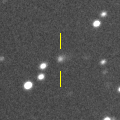
|
Now it is 16.1 mag (Mar. 18, Toshihiko Ikemura, Hirohisa Sato). It stays observable at 16-17 mag from 2020 to 2021. It locates somewhat low in the Northern Hemisphere.
Date(TT) R.A. (2000) Decl. Delta r Elong. m1 Best Time(A, h)
Apr. 25 10 40.78 -19 43.7 5.897 6.582 129 16.5 20:26 ( 0, 35)
May 2 10 41.13 -19 3.5 5.968 6.581 123 16.6 20:20 ( 6, 36)
|

|
It brightened up to 7.7 mag in June in 2018 (June 19, Juan Jose Gonzalez). Now it is fading. It has already faded down to 16.4 mag (Mar. 20, Toshihiko Ikemura, Hirohisa Sato). In the Southern Hemisphere, it stays observable for a long time until the comet will fade out. In the Northern Hemisphere, it stays low for a while.
Date(TT) R.A. (2000) Decl. Delta r Elong. m1 Best Time(A, h)
Apr. 25 5 40.97 -14 42.8 6.988 6.527 59 16.6 20:12 ( 67, 6)
May 2 5 43.88 -13 58.0 7.113 6.581 54 16.6 20:20 ( 73, 0)
|

|
Now it is 15.8 mag (Mar. 1, iTelescope Observatory, Siding Spring). It is observable at 16.5 mag in 2020. It is observable in excellent condition in the Southern Hemisphere. It locates somewhat low in the Northern Hemisphere.
Date(TT) R.A. (2000) Decl. Delta r Elong. m1 Best Time(A, h)
Apr. 25 20 4.21 -29 51.2 6.384 6.599 97 16.6 3:44 (331, 19)
May 2 20 0.89 -29 49.8 6.271 6.610 105 16.6 3:34 (335, 20)
|
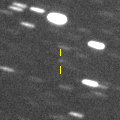
|
Now it is 17.6 mag (Mar. 22, Toshihiko Ikemura, Hirohisa Sato). It will brighten up to 15.5 mag from June to August, and it will be observable in good condition.
Date(TT) R.A. (2000) Decl. Delta r Elong. m1 Best Time(A, h)
Apr. 25 18 59.37 -7 13.1 1.672 2.213 108 16.8 3:44 (338, 45)
May 2 19 6.45 -6 14.9 1.586 2.192 113 16.6 3:34 (341, 47)
|
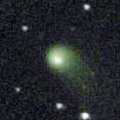
|
It brightened up to 12-13 mag from 2018 to 2019. Now it is fading. It has already faded down to 16.5 mag (Mar. 8, John Drummond). In the Southern Hemisphere, it stays observable in good condition for a long time. It will never be observable after this in the Northern Hemisphere.
Date(TT) R.A. (2000) Decl. Delta r Elong. m1 Best Time(A, h)
Apr. 25 9 36.53 -71 0.4 4.884 5.303 109 16.7 20:12 ( 4,-16)
May 2 9 26.76 -69 23.9 4.940 5.349 108 16.8 20:20 ( 9,-16)
|
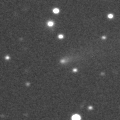
|
Now it is 16.3 mag (Apr. 4, Purple Mountain Observatory, XuYi Station). It will be fading after this, and it will be fainter than 18 mag in late June.
Date(TT) R.A. (2000) Decl. Delta r Elong. m1 Best Time(A, h)
Apr. 25 13 6.46 0 50.7 1.243 2.211 158 16.7 22:51 ( 0, 56)
May 2 13 3.17 0 45.2 1.286 2.225 151 16.8 22:20 ( 0, 56)
|
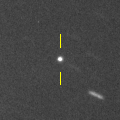
|
Now it is 16.1 mag (Mar. 18, Toshihiko Ikemura, Hirohisa Sato). It will be fading after this, and it will be fainter than 18 mag in late June.
Date(TT) R.A. (2000) Decl. Delta r Elong. m1 Best Time(A, h)
Apr. 25 10 0.07 9 34.6 0.961 1.648 113 16.8 20:12 ( 15, 64)
May 2 10 3.07 5 50.8 1.018 1.648 108 16.9 20:20 ( 28, 57)
|
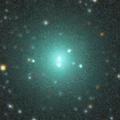
|
It brightened up to 10.2 mag in February (Feb. 6, Maik Meyer). Now it is fading rapidly. It has already faded down to 15.0 mag (Apr. 15, Thomas Lehmann). It is observable in good condition in the Northern Hemisphere. In the Southern Hemisphere, it is only visible in the extremely low sky in spring.
Date(TT) R.A. (2000) Decl. Delta r Elong. m1 Best Time(A, h)
Apr. 25 6 5.75 38 45.1 2.324 1.976 57 16.9 20:12 (114, 39)
May 2 6 14.19 36 32.2 2.517 2.062 52 17.5 20:20 (114, 33)
|
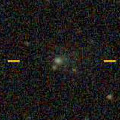
|
Now it is 16.4 mag (Apr. 14, Katsumi Yoshimoto). It will brighten up to 17 mag and will be observable in excellent condition from March to May.
Date(TT) R.A. (2000) Decl. Delta r Elong. m1 Best Time(A, h)
Apr. 25 12 37.12 -2 16.5 1.150 2.102 154 17.0 22:21 ( 0, 53)
May 2 12 35.46 -1 55.6 1.182 2.101 147 17.1 21:52 ( 0, 53)
|
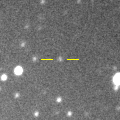
|
Now it is 17.3 mag (Mar. 23, Toshihiko Ikemura, Hirohisa Sato). It is expected to brighten up to 13 mag in 2022. In 2020, it is observable in excellent condition in the Southern Hemisphere. In the Northern Hemisphere, it will be unobservable soon. It will be observable again from autumn to winter, but it locating extremely low.
Date(TT) R.A. (2000) Decl. Delta r Elong. m1 Best Time(A, h)
Apr. 25 6 21.06 -28 3.1 7.627 7.400 73 17.1 20:12 ( 51, 4)
May 2 6 24.62 -27 32.1 7.646 7.359 69 17.1 20:20 ( 56, -1)
|
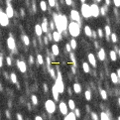
|
Now it is 17.5 mag (Mar. 20, Toshihiko Ikemura, Hirohisa Sato). It will be observable at 16.5-17 mag from spring in 2020 to summer in 2021.
Date(TT) R.A. (2000) Decl. Delta r Elong. m1 Best Time(A, h)
Apr. 25 19 55.37 22 49.0 4.805 4.882 88 17.2 3:44 (287, 61)
May 2 19 51.32 23 13.1 4.686 4.864 94 17.1 3:34 (292, 66)
|
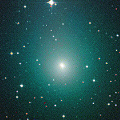
|
It brightened up to 8.3 mag in September (Sept. 20, Maik Meyer). Now it is fading. In the Southern Hemisphere, it stays observable for a long time after this. In the Northern Hemisphere, it will never be observable again.
Date(TT) R.A. (2000) Decl. Delta r Elong. m1 Best Time(A, h)
Apr. 25 0 49.28 -59 1.9 3.444 3.312 74 17.2 3:44 (322,-36)
May 2 1 3.39 -60 43.0 3.438 3.382 78 17.3 3:34 (324,-36)
|

|
Now it is 17.3 mag (Mar. 24, Toshihiko Ikemura, Hirohisa Sato). It stays observable at 16-17 mag for a long time until 2024.
Date(TT) R.A. (2000) Decl. Delta r Elong. m1 Best Time(A, h)
Apr. 25 16 13.94 -18 30.6 9.090 9.974 149 17.3 2:02 ( 0, 36)
May 2 16 9.97 -18 13.7 9.016 9.956 157 17.3 1:31 ( 0, 37)
|

|
Now it is 18.3 mag (Mar. 22, Toshihiko Ikemura, Hirohisa Sato). It will be fading slowly after this. It is observable in good condition in the Northern Hemisphere. In the Southern Hemisphere, it is observable in the extremely low sky only in 2021 spring.
Date(TT) R.A. (2000) Decl. Delta r Elong. m1 Best Time(A, h)
Apr. 25 12 51.07 55 5.4 8.416 8.806 109 17.4 22:35 (180, 70)
May 2 12 47.61 54 36.3 8.483 8.818 106 17.4 22:04 (180, 71)
|

|
Now it is 18.1 mag (Mar. 24, Pan-STARRS 1, Haleakala). It will brighten up to 15.5 mag in early 2021. In 2020, it stays observable at 17 mag until November in the Southern Hemisphere, or until July in the Northern Hemisphere.
Date(TT) R.A. (2000) Decl. Delta r Elong. m1 Best Time(A, h)
Apr. 25 14 44.83 -33 30.9 2.714 3.667 158 17.7 0:33 ( 0, 21)
May 2 14 38.44 -33 27.2 2.643 3.614 161 17.5 23:55 ( 0, 21)
|

|
Now it is 17.6 mag (Feb. 3, ATLAS-HKO, Haleakala). It brightened up to 14 mag from autumn to winter in 2018. Now it is fading. It will be fainter than 18 mag in May.
Date(TT) R.A. (2000) Decl. Delta r Elong. m1 Best Time(A, h)
Apr. 25 12 58.50 -2 59.9 3.860 4.815 159 17.5 22:43 ( 0, 52)
May 2 12 53.77 -3 1.5 3.942 4.853 151 17.7 22:10 ( 0, 52)
|
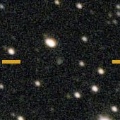
|
Now it is 17.6 mag (Mar. 21, Toshihiko Ikemura, Hirohisa Sato). It will be observable at 16.5-17 mag from 2020 to 2021.
Date(TT) R.A. (2000) Decl. Delta r Elong. m1 Best Time(A, h)
Apr. 25 1 40.38 66 54.1 6.875 6.335 53 17.6 3:44 (202, 23)
May 2 1 44.89 66 57.4 6.884 6.319 52 17.6 3:34 (203, 24)
|
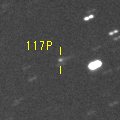
|
Now it is 17.4 mag (Mar. 18, Toshihiko Ikemura, Hirohisa Sato). It will brighten up to 13 mag in 2022. In 2020, it is observable at 17.5 mag in good condition in spring. It locates somewhat low in the Southern Hemisphere.
Date(TT) R.A. (2000) Decl. Delta r Elong. m1 Best Time(A, h)
Apr. 25 10 8.50 21 42.0 3.974 4.437 111 17.6 20:12 ( 18, 76)
May 2 10 8.69 21 24.6 4.061 4.424 104 17.7 20:20 ( 44, 72)
|
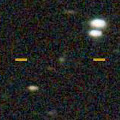
|
Now it is 17.6 mag (Apr. 4, Catalina Sky Survey). It became brighter than orignally predicted. It stays observable at 17 mag in good condition until autumn.
Date(TT) R.A. (2000) Decl. Delta r Elong. m1 Best Time(A, h)
Apr. 25 12 49.65 -6 56.0 1.379 2.347 159 17.8 22:34 ( 0, 48)
May 2 12 45.00 -6 52.5 1.389 2.324 151 17.7 22:02 ( 0, 48)
|

|
It will pass the perihelion in 2021, and it is predicted to be observable at 17-18 mag from 2020 to 2022. However, it has not been observed at all since 2015. It was not detected, fainter than 20.5 mag, in 2017 May (Werner Hasubick).
Date(TT) R.A. (2000) Decl. Delta r Elong. m1 Best Time(A, h)
Apr. 25 20 34.70 -22 14.4 6.026 6.102 89 17.8 3:44 (321, 22)
May 2 20 37.03 -22 6.4 5.903 6.088 95 17.7 3:34 (324, 24)
|
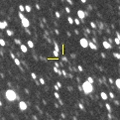
|
Now it is 17.8 mag (Oct. 9, Toshihiko Ikemura, Hirohisa Sato). It stays observable at 18 mag for a long time from 2019 to 2021.
Date(TT) R.A. (2000) Decl. Delta r Elong. m1 Best Time(A, h)
Apr. 25 19 17.89 -15 52.4 7.342 7.681 106 17.8 3:44 (336, 36)
May 2 19 17.09 -16 17.3 7.231 7.682 113 17.7 3:34 (341, 37)
|

|
Now it is 18.3 mag (Apr. 6, J. L. Virlichie, P. Traverse). It will brighten up to 16.5 mag and will be observable in good condition from June to October.
Date(TT) R.A. (2000) Decl. Delta r Elong. m1 Best Time(A, h)
Apr. 25 19 58.79 1 9.9 2.116 2.384 92 17.9 3:44 (313, 46)
May 2 20 6.55 2 45.7 2.023 2.362 96 17.8 3:34 (315, 49)
|
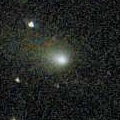
|
It brightened up to 13.8 mag in 2019 winter (Dec. 21, Thomas Lehmann). Now it is fading. It has already faded down to 17.2 mag (Mar. 18, Toshihiko Ikemura, Hirohisa Sato). It will be fainter than 18 mag in May. In the Northern Hemisphere, it is observable in excellent condition. It locates low in the Southern Hemisphere.
Date(TT) R.A. (2000) Decl. Delta r Elong. m1 Best Time(A, h)
Apr. 25 7 6.01 9 8.7 1.917 1.874 72 17.9 20:12 ( 73, 38)
May 2 7 21.99 8 24.8 2.009 1.910 69 18.1 20:20 ( 76, 33)
|
|
![]()
 (944) Hidalgo
(944) Hidalgo C/2019 T3 ( ATLAS )
C/2019 T3 ( ATLAS ) 117P/Helin-Roman-Alu 1
117P/Helin-Roman-Alu 1 278P/McNaught
278P/McNaught C/2014 F3 ( Sheppard-Trujillo )
C/2014 F3 ( Sheppard-Trujillo ) C/2017 K5 ( PanSTARRS )
C/2017 K5 ( PanSTARRS ) 257P/Catalina
257P/Catalina 114P/Wiseman-Skiff
114P/Wiseman-Skiff![]()












































